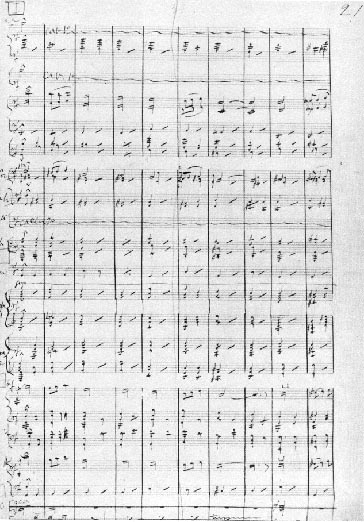|
�I�ve got a tune that will knock �em - knock �em flat,� Elgar announced to his friend
Dora Penny, Dorabella of the Enigma Variations, in May 1901. It was a tune that was
to become very familiar to a large number of people on both sides of the Atlantic, but for
quite different reasons.
The tune had begun life as the trio section for Elgar�s March in D major early in the
year. (A trio was originally the central section of a dance tune, so called because it was
played by three instruments. It is normally in a different key from a work�s main melody.
Elgar�s trio here is in G major.) The D major march became the first in a series of five
marches that Elgar named Pomp and Circumstance, taking their title from a speech in
Act 3 of Shakespeare�s Othello:
Farewell the neighing steed and the shrill trump,
The spirit-stirring drum, the ear-piercing fife,
The royal banner, and all quality,
Pride, pomp, and circumstance of glorious war!
 |
The manuscript score of the trio
of Pomp and Circumstance March No. 1
|
|
The D major march was given its first performance, along with a second march in A minor
on 19 October 1901 at Philharmonic Hall, Liverpool with the Liverpool Orchestral Society
Orchestra conducted by Elgar. It was long thought that the premier had been conducted by
Elgar's great friend Alfred Rodewald, to whom it is dedicated. However, recent research at
the Elgar
Birthplace has revealed that both the programme and the subequent reviews of the concert
indicate that Elgar was the conductor. Alfred Rodewald conducted the rest of the programme,
which included Beethoven's third Piano Concerto and Glazunov's fifth Symphony.
The great acclaim afforded the work there was surpassed at the London premi�re three days
later. The conductor, Henry Wood, recorded: �The people simply rose and yelled. I had to play
it again - with the same result; in fact, they refused to let me go on with the programme.
After considerable delay [and] merely to restore order I played the march a third time. And
that, I may say, was the one and only time in the history of the Promenade concerts that such
an orchestral item was accorded a double encore.�
While listening to the tune in November 1901, the great contralto, Clara Butt asked Elgar
if he could write something like it for her. �You shall have that one my dear� was Elgar�s
reply. He then came up with the idea of using the trio tune as the finale of his
Coronation Ode, which Clara Butt planned to perform
with a full chorus and orchestra to celebrate the crowning of King Edward VII. For the words,
he turned to Arthur Christopher Benson who submitted his first draft of
�Land of Hope and Glory� on 10 December 1901.
Although the Coronation Ode was completed by 1
April 1902, its intended premi�re on 30 June had to be abandoned because the king was taken
ill. Meanwhile, with an eye to the potential sales of the vocal version, Elgar�s publishers,
Booseys, asked him to produce a modified adaptation, and this was duly performed for the
first time by Clara Butt on 21 June. In Britain today the Pomp and Circumstance March
No. 1 is inexorably linked with the words �Land of Hope and Glory� and has become
a second national anthem.
|